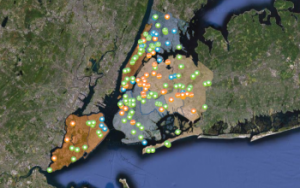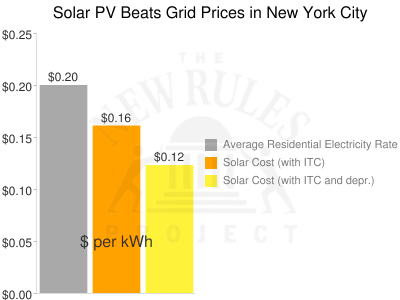 This post adapted from Energy Self-Reliant States, a resource of the Institute for Local Self-Reliance’s New Rules Project.
This post adapted from Energy Self-Reliant States, a resource of the Institute for Local Self-Reliance’s New Rules Project.
A recently released solar map of New York City found enough room on building rooftops for solar panels to power half the city during hours of peak electricity use. Taking advantage of this solar windfall could allow New Yorkers to save millions on electricity costs and create tens of thousands of jobs.
New York City is not alone in its solar power potential.
Almost 60 million Americans live in areas where solar prices are competitive with retail electricity costs, but this opportunity is often kept out of reach by utilities and the antiquated rules of the U.S. electricity system.
During the last century, the electricity system was centrally planned and controlled. Monopoly utilities delivered inexpensive electricity in return for guaranteed profits from state regulators. Americans accepted the environmental consequences and centralized control of the electric grid because they were largely without economical alternatives, like rooftop solar.
The system has changed. The rapidly falling cost of renewable energy offers a dramatically different electricity future. Millions of Americans could become power generators instead of just consumers, sharing in the economic benefits of clean energy, but only if they can wrest back control of their electric grid.
As it stands, antiquated state and utility rules put a gridlock on the electric system. Just as the old AT&T monopoly limited which phones could connect to their network, utilities make connecting new wind and solar projects arbitrarily difficult. Renewable energy projects also face complex paperwork and long delays to get online, making it harder to get loans and finance projects. The Clean Coalition, a California-based renewable energy group, reports that many as 97 percent of renewable energy projects seeking a contract and grid connection under California’s renewable energy law fail to do so. Millions of dollars and renewable megawatts are stranded by the rules of the electric system.
The rules are little better at the federal level, where regulators oversee regional electricity grid planning. Under the 2005 Energy Policy Act, the Federal Energy Regulatory Commission (FERC) has routinely awarded bonus incentives for new transmission line development at the expense of local power generation. Although FERC has issued its Rule 890 requiring regional planning authorities to examine cost effective alternatives to new power lines (such as local solar power), FERC chairman Jon Wellinghoff says that the Commission largely leaves the policing of this rule to the stakeholder process, one he admits is dominated by incumbent utilities and transmission line developers.
Ultimately, the utilities remain tied to a system that supports their business model, a guaranteed rate of return on new centralized power plants or transmission lines but few rewards for allowing third parties to replace dirty fossil fuel power with clean, local renewable energy.
While the barriers to progress are significant, the rewards for changing the system are enormous.
New York City could supply 14 percent of its total electricity from rooftop solar alone, transform over 50,000 homes and businesses into energy producers, and create over 40,000 jobs. Because the city has good sun and high electricity prices, switching to solar would save New Yorkers millions of dollars on their electric bills.
In Washington, DC, maximizing electricity production from rooftop solar could supply 20 percent of the city’s electricity. Covering the District’s roofs with solar power could also save $250 million in electricity costs and boost the local economy by up to $1.5 billion, and create over 14,000 jobs.
Every state has a similar opportunity. More than 30 states could generate all their electricity locally, from in-state renewable energy sources, according to the Institute for Local Self-Reliance. With wind power prices already competitive in electricity wholesale markets and with solar prices competitive at retail prices for 20 percent of America, millions of Americans could help break the utility grid lock and become energy producers, save money, and create jobs.
The 21st century is calling with a promise of clean, local electricity production and a more democratic electricity system. But without a challenge to the utilities, the economic and clean energy opportunity may be lost.




